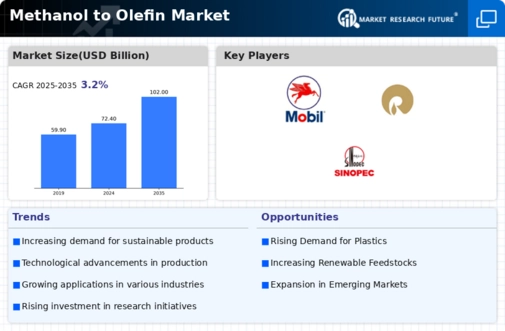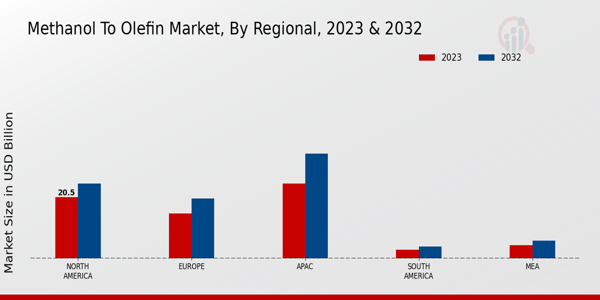Market Growth Projections
The Global Methanol to Olefin Market Industry is projected to experience substantial growth over the coming years. With a market valuation of 72.4 USD Billion in 2024, it is anticipated to reach 102.0 USD Billion by 2035. This growth trajectory indicates a compound annual growth rate of 3.17% from 2025 to 2035. Various factors, including rising demand for petrochemicals, technological advancements, and supportive government policies, are likely to drive this expansion. The market's resilience in adapting to changing consumer preferences and regulatory landscapes suggests a promising outlook for stakeholders involved in the methanol to olefin production chain.
Technological Advancements
Innovations in methanol-to-olefin technologies are significantly enhancing the efficiency and cost-effectiveness of production processes within the Global Methanol to Olefin Market Industry. Recent advancements, such as improved catalysts and reactor designs, are enabling higher yields and lower energy consumption. These technological improvements not only reduce operational costs but also minimize environmental impacts, aligning with global sustainability goals. As companies adopt these cutting-edge technologies, the market is expected to witness a steady growth rate, with projections indicating a market size of 102.0 USD Billion by 2035. This trend suggests that technological evolution will play a pivotal role in shaping the future landscape of the industry.
Growing Focus on Sustainability
The Global Methanol to Olefin Market Industry is increasingly influenced by a growing focus on sustainability and environmental responsibility. Companies are recognizing the importance of adopting sustainable practices in their operations, leading to a shift towards methanol as a cleaner alternative to traditional feedstocks. This trend is driven by consumer preferences for eco-friendly products and the need for industries to comply with environmental regulations. As sustainability becomes a core business strategy, the demand for methanol-derived olefins is likely to increase, fostering market growth. This shift not only supports environmental goals but also positions the industry for long-term viability in a rapidly changing global landscape.
Rising Demand for Petrochemicals
The Global Methanol to Olefin Market Industry is experiencing a surge in demand for petrochemicals, driven by the increasing consumption of plastics and synthetic fibers. As industries expand, the need for ethylene and propylene, key products derived from methanol, is projected to grow. In 2024, the market is valued at 72.4 USD Billion, reflecting the robust growth trajectory. This demand is further fueled by the automotive and construction sectors, which utilize these petrochemicals extensively. The shift towards lightweight materials in vehicles and infrastructure development is likely to sustain this demand, positioning the Global Methanol to Olefin Market Industry favorably for future growth.
Government Policies and Regulations
Government policies aimed at promoting cleaner energy sources and reducing carbon emissions are influencing the Global Methanol to Olefin Market Industry. Many countries are implementing regulations that encourage the use of methanol as a feedstock due to its lower environmental impact compared to traditional fossil fuels. Incentives for renewable energy and stricter emissions standards are likely to drive investments in methanol production facilities. This regulatory environment not only supports the growth of the methanol industry but also aligns with global efforts to transition towards sustainable energy solutions. As a result, the market is expected to expand, reflecting a compound annual growth rate of 3.17% from 2025 to 2035.
Increasing Investment in Infrastructure
The Global Methanol to Olefin Market Industry is benefiting from increased investments in infrastructure development across various regions. Governments and private entities are allocating substantial resources to enhance transportation networks and industrial facilities, which in turn boosts the demand for olefins. The construction of new methanol plants and the expansion of existing facilities are indicative of this trend. As infrastructure projects proliferate, the need for olefins in construction materials and other applications is likely to rise. This growing investment landscape is expected to contribute positively to the market's growth, reinforcing its position as a critical component of the global chemical industry.














